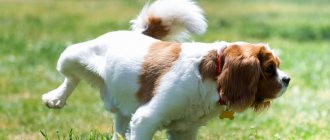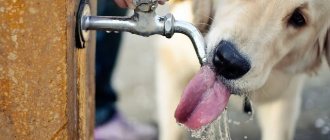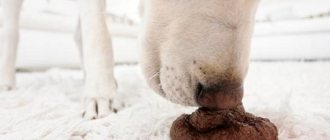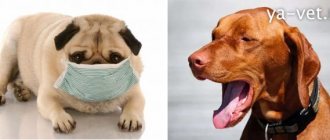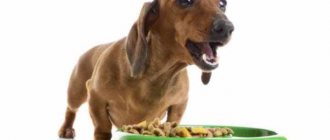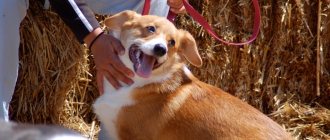How does the dog's urinary system work?
The urinary system is responsible for removing waste from the blood through urine (urine), and also maintains acidity and electrolyte balance. It consists of:
- The kidney is a bean-shaped organ responsible for filtering blood. Its main part is the nephrons, which screen out waste products of the body from the plasma, form urine, sending it to the ureter through the calyces and the renal pelvis.
- The ureters are tubes through which urine from the kidneys enters the bladder using peristalsis (wave-like muscle contractions).
- The bladder is a bag for temporary storage of urine. As it fills with urine, it stretches and at a certain stage begins to irritate the nerve endings. The brain receives a signal and orders it to empty.
What happens next is:
- The valves (sphincter muscles) that prevent urine from spontaneously flowing out of the bladder relax.
- The detrusor, the muscle layer inside the bladder, contracts.
- Urine, under the influence of the detrusor, opens the valves and flows out through the urethra (urethra). In females it is shorter, in males it is longer.
Small puppies are unable to control the process of urination, but as they grow and are raised, they learn to hold urine and urinate in the right place. This happens due to muscle tension, including the pelvic floor.
Methods of punishment
If the dog does piss on the bed, adequate punishment should be applied.
It is useless to punish a dog if more than an hour has passed since the incident. It is advisable to catch the scoundrel at the crime scene.
The following sanctions can be applied:
- Take the puppy by the scruff of the neck (as a mother would do), shake it lightly but firmly and strictly say “no,” “no,” or “ugh.”
- Lightly slap a thin twig on the withers to express your dissatisfaction.
- Deprive the puppy of his favorite toy or stop the game if he is naughty.
- Point to his place (do not allow him to leave the mat) or briefly lock him in a room where no one is present.
Expert opinion
Anna Abramenko
An avid dog lover. Experience in veterinary medicine since 2009.
Ask a Question
Under no circumstances should you hit the dog, shout at it, or deprive it of food or water. Such measures can only aggravate the situation and also harm the health of the pet.
Corrected behavior in a timely manner will help raise an obedient and intelligent companion.
Main symptoms of urinary incontinence in dogs
If the pet couldn’t bear it and left a puddle, this is not a problem, and it’s too early to talk about incontinence. You need to be wary when such a phenomenon as “dripping” urine appears, the dog’s genitals turn red, and she diligently licks them. There are wet spots on the animal's bedding; it is damp and stinks.
Other symptoms of incontinence:
- increased frequency of urination;
- pain during bowel movements;
- lethargy;
- weight loss;
- thirst;
- change in appetite.
Red urine and vomiting are warning signs that require an urgent visit to the doctor.
Help of chemicals
When a dog begins to leave puddles on the furniture, carpet or floor, and cannot be retrained, you can use specially developed means for toilet training the animal. They are available in almost any pet store.
It is advisable to use them in combination:
- Deterrent drugs. Problem areas are treated, the smell of the products does not allow the puppy to get closer, and therefore protects from unwanted puddles. Simple table vinegar has the same property. It’s important not to overdo it here—pure essence can destroy a dog’s sense of smell. Mix a few drops of the product in water and wipe the desired surface.
- Attractive drugs (powders, sprays, wipes). They are added to the tray filler, dogs like the smell - they relieve themselves in the right place.
As a last resort, you can use special absorbent wipes. Place them around the perimeter and throw them away after use.
Causes of involuntary urination in dogs
Urinary incontinence can affect any pet. At risk are spayed middle-aged and older females. Pathology occurs due to weakening of the sphincter, as well as stones in the bladder or urethra. Having determined the causes of urinary incontinence in an old dog, treatment must be strictly adhered to. You will probably need pet diapers.
Other causes of urinary incontinence in dogs that require treatment:
- bladder inflammation or infection (cystitis);
- weak detrusor;
- sterilization;
- spinal injury (degeneration);
- stress;
- kidney disease;
- spinal cord abnormalities;
- congenital pathologies;
- prostate diseases;
- diabetes mellitus and other conditions that cause increased thirst and metabolic disorders.
Congenital pathologies
The most common birth defect that causes involuntary urination is ectopic ureter, when it bypasses the bladder and connects to the urethra. Due to the absence of a valve here that holds back urine, liquid will drip even from young animals.
The problem is most often encountered by huskies. Also prone to pathology:
- miniature poodle;
- Labrador Retriever;
- collie;
- Welsh Corgi;
- Wire Fox Terrier;
- West Highland White Terrier.
The pathology is more often recorded in females. If the anomaly is only in one ureter, the pet will excrete urine drop by drop, almost imperceptibly, and urinate normally. If the structure of the two ureters is incorrect, urine will only drip, and the animal will not be able to empty itself normally.
To determine the causes of urinary incontinence in a young dog and treatment, consult a doctor. If the diagnosis shows ectopic ureter, the only solution to the problem is surgery.
Urinary tract infections
The most common problem that owners of bitches face is cystitis, caused by a bacterial infection. Pathology often develops due to hypothermia. The disease can be transmitted sexually during mating or swimming in a dirty pond. Bitches are more likely to experience cystitis due to their shorter urethra than that of males. If a young or old dog has urinary incontinence, treatment should be prescribed by a doctor.
Antibiotics are prescribed for cystitis. If the pathology is not treated, the bladder may become scarred, causing it to lose its elasticity and ability to stretch normally. The disease will become chronic, and you will have to walk the animal often.
Prostate in males
The cause of urinary incontinence in a dog can be prostatitis - inflammation of the prostate gland. Its increase impairs the flow of urine, interferes with normal emptying, causes a weak stream, frequent urination or leakage. This problem of urinary incontinence in an old dog is usually fixed. Antibiotics are prescribed for treatment.
Sterilization
The symptom is observed in sterilized pets of both sexes, and blood and urine tests are normal. Incontinence can last from several months until the end of the animal's life.
There are several explanations:
- Hormonal disorders - estrogen deficiency in females, testosterone in males.
- A poorly performed operation.
- Changes in the length of the urethra, which leads to its displacement and worsening of valve closure. Presumably, as the dog ages, the problem with urination increases.
Urolithiasis disease
The cause of urinary incontinence in an old dog is stones. They are formed from various types of salts in the kidneys or bladder. The formations may not make themselves felt until they block the passage or reach a large size. Incontinence can occur if a stone gets stuck in the valve area and prevents it from closing. If the formation completely blocks urine output, the animal may die within a few days.
If a young or old dog has urinary incontinence, what to do is consult a veterinarian. Previously, stones were treated only surgically and a diet was prescribed. Now there are technologies that can crush formations without serious surgical intervention. The method of treating urinary incontinence in a dog will depend on the doctor and the technical capabilities of his clinic.
Nervous system problems
The functioning of the urethra is controlled by the brain, sending a signal along nerve fibers that are woven into the spinal cord. If these tissues are affected, incontinence may occur. For the same reason, a pet does not hold urine if there is a spinal injury.
The symptom is accompanied by muscle weakness, complete or partial paralysis is possible.
Fear
The dog involuntarily urinates, fearing to upset the owner. She can wait for him all day without any problems, and as soon as she sees him, she will have a bowel movement while waiting for him to go for a walk.
The problem often arises due to improper toilet training, when the puppy was shouted at or hit for puddles. The first thing to do if a dog has urinary incontinence due to fear of punishment is to establish the most trusting contact so that the animal is not afraid of the owner. You may need the help of an animal psychologist.
Incorrect feeding regimen
An unregulated diet and drinking regime often leads to an adult dog peeing at home. It is important to remember that food is digested in approximately 30 - 40 minutes, and the absorption time of liquid is 15 - 20 minutes. Based on this, it will be easier to correctly set a schedule for feeding and watering the animal and coordinate the time of walking the pet with this. You should strive not to overfeed or overdose your dog. Experienced dog breeders note that strict adherence to feeding, watering and walking schedules for their pet helps prevent the dog from urinating in the house. Therefore, it would be useful to make sure that no one in the house feeds or waters the dog at an unspecified time.
A large time interval between evening and morning walking. This oversight by the owners leads to the dog peeing at home at night. During an evening walk, for example, because it was raining or the owner was in a hurry to go home, the pet did not have time to choose a suitable place for the toilet. As a result, the dog is not walked enough. If the dog woke up early and will only be walked in two hours, it is unlikely that he will wait until then. Here you need to change your walking schedule. It is better to take an evening walk as late as possible, and in the morning you should try to go out early.
Diagnosis and treatment of urinary disorders in dogs
Contact a good clinic to find out the causes of urinary incontinence, treatment, medications. The doctor will make a diagnosis based on urine, blood, ultrasound, and x-ray tests. An MRI may be needed, but veterinary clinics rarely provide this option. We must look for exits to the human laboratory.
Depending on the disease, your veterinarian will determine how to treat your dog's urinary incontinence. There are three options for treating the problem:
- Conservative – the doctor prescribes antibiotics, anti-inflammatory, hormonal drugs, and recommends a diet.
- Surgical – used for abnormalities in the structure of the urinary system or the presence of stones.
- Radical – euthanasia, when the owner does not want to treat the animal.
To prevent your pet from dirtying the floor, furniture, and bedding, buy diapers. Important: buy pads taking into account not only the size, but also the gender of the animal. The cut of diapers for females and males is different.
Security measures
It is important to remember that home cleaning products must be chosen based on the upholstery material.
To prevent deformation of the sofa structure and to avoid irreparably damaging the fabric of the furniture, observe the following rules:
- There is no need to scrub the stain vigorously with a sponge, rag or brush, this will make the situation worse and the urine will penetrate deep into the fabric. It is important to get wet to absorb as much moisture as possible;
- Do not overfill the stain. The affected area will be difficult to dry, leading to mold and a musty odor;
- The effects of household chemicals are checked in advance on the internal areas of the sofa before use;
- When using any chemical, you must strictly follow the instructions;
- You should not try to clean delicate fabrics and lint yourself. It is better to immediately contact the dry cleaner;
- After treatment, it is necessary to ventilate the room as much as possible.
Preventing urinary incontinence in pets
To prevent urinary incontinence, follow these recommendations:
- Don't keep your dog in the cold. If she lives outside, take her home during frosts. Make a warm enclosure.
- Do not allow your pet to lie on a draft or cold floor.
- Walk regularly, if possible - 3 times a day. Preferably at least an hour.
- Do not prevent your pet from urinating frequently outside. An empty bladder will leak less, and it will be easier for the dog to wait for a walk.
- Keep the house clean and wash her bedding regularly. It will be more difficult for bacteria to penetrate the animal's urinary system.
- Do not punish your dog for puddling, otherwise the problem may worsen or appear.
- Monitor the animal's weight.
- Don't give food from the table.
Treat urinary tract diseases in a timely manner. If the dog behaves suspiciously, take its temperature; it should not exceed 38.5 degrees. Contact your veterinarian immediately with any concerns.
If dogs have urinary incontinence, buy medications for treatment only at a certified pharmacy, for example, Gomeovet. Products purchased in ordinary veterinary stores, and even more so at the market, may turn out to be fake. In an attempt to make money, scammers counterfeit not only expensive but also cheap drugs. Therefore, it is not worth the risk.
Excessive gentleness in education
The other extreme in pet dog breeding is that owners overindulge their beloved animal, allowing it to do almost everything. A complete lack of strictness leads to the same result - the dog pees at home. It is important to remember that it is not a person who lives with an animal, but an animal with a person. Therefore, the dog must clearly understand the following fact: it is not the master of the house, but the person. It is important to avoid this imbalance in attitude towards your pet. But if a mistake was made, you don’t need to think that everything is hopeless. The situation can be brought under control if gentle corrective measures are systematically introduced. The dog will quickly learn the lesson, and everything will fall into place. Soon, wet puddles on carpets will be a thing of the past.

